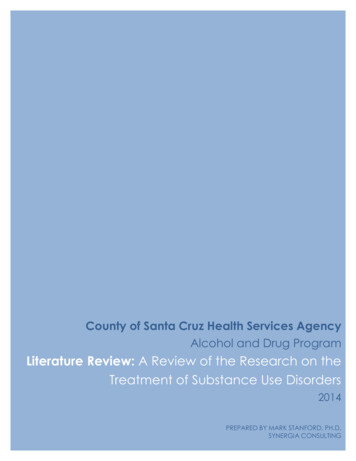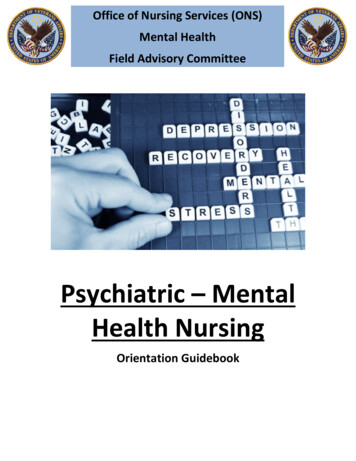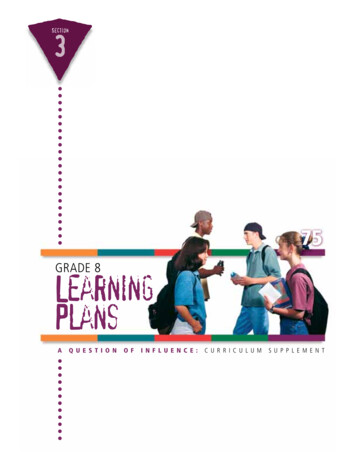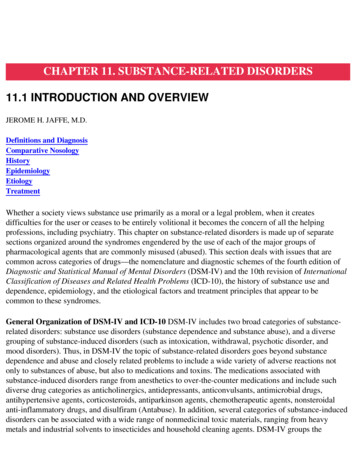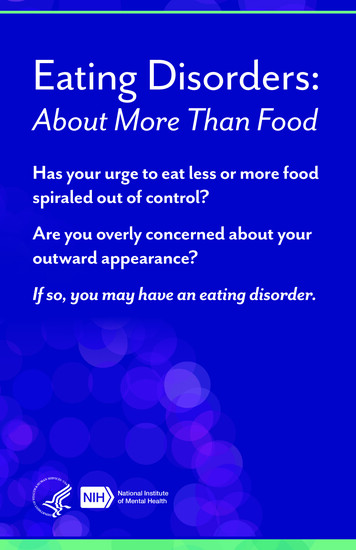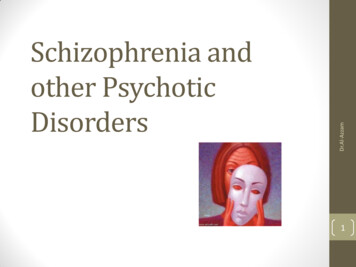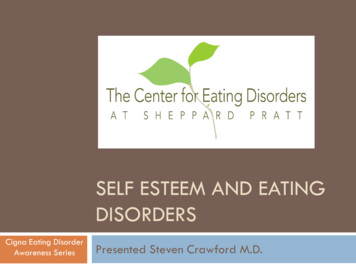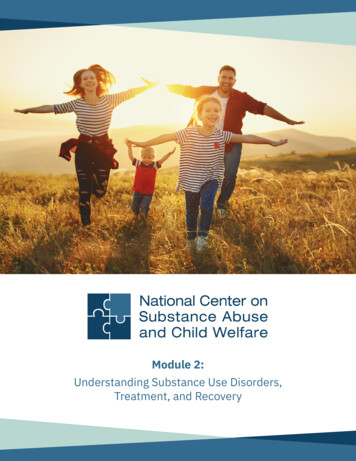
Transcription
Module 2:Understanding Substance Use Disorders,Treatment, and Recovery
ContentsIntroduction . 2Intended Audience . 3Facilitator Qualifications . 3Terminology . 3Module 2 Description and Objectives . 4Training Tips . 4Materials . 4PowerPoint Presentation and Talking Points. 5References .73Resources.771
IntroductionThe National Center on Substance Abuse and Child Welfare (NCSACW) developed theChild Welfare Training Toolkit to educate child welfare workers about substance useand co-occurring disorders among families involved in the child welfare system. Thetraining is intended to provide foundational knowledge to help child welfare workers:1.2.3.4.5.Understand substance use and co-occurring disorders.Identify when substance use is a factor in a child welfare case.Learn strategies for engaging parents and families in services.Understand potential effects for the parent, children, and caregivers.Learn the importance of collaboration within a system of care. Through a deeperunderstanding of these topics, child welfare workers can apply knowledgegained to their casework and improve their own practice.The Training Toolkit consists of 10 modules—7 core and 3 special topics trainingmodules:Module 1: Understanding the Multiple Needs of Families Involved with the ChildWelfare SystemModule 2: Understanding Substance Use Disorders, Treatment, and RecoveryModule 3: Understanding Co-Occurring Substance Use Disorders, MentalHealth/Trauma, and Domestic ViolenceModule 4: Engagement and Intervention with Parents Affected by Substance UseDisorders and Mental Health/TraumaModule 5: Case Planning, Family Strengthening, and Planning for Safety for Familieswith a Substance Use DisorderModule 6: Understanding the Needs of Children of Parents with Substance Use orCo-Occurring DisordersModule 7: Collaborating to Serve Parents with Substance Use DisordersSpecial Topic: Considerations for Families in the Child Welfare System Affected byMethamphetamineSpecial Topic: Considerations for Families in the Child Welfare System Affected byOpioidsSpecial Topic: Understanding Prenatal Substance Exposure and Child WelfareImplicationsThe entire Training Toolkit can be delivered in a series, or each module can bedelivered individually as a stand-alone training. Each module is approximately 2 hoursin length and contains a range of materials that can be adapted to meet the needs of2
child welfare trainers for in-person workshops or more formal training sessions. Thisflexibility allows the facilitator to determine the best format and timing for the training,according to the needs of the agency and staff. The special topics, in particular, lendthemselves to brown-bag or lunchtime trainings.Each module includes a Facilitator’s Guide with training goals and learning objectives, aPowerPoint presentation, resources, and references. The PowerPoint presentationcontains talking points and key details in the notes section of the slides. These talkingpoints are not intended to serve as a script to read aloud to attendees, but rather as keypoints to highlight while presenting. Facilitators are encouraged to infuse their owncontent knowledge, expertise, and real-world experience to bring the training to life.NCSACW integrated discussion questions and experiential activities throughout thetraining sessions.The Facilitator’s Guide includes a list of resources where facilitators and participants canfind additional information on related topics. Facilitators can customize content to includestate or local child welfare practice information and terminology where appropriate.NCSACW provides a free online tutorial, Understanding Substance Use Disorders,Treatment, and Family Recovery: A Guide for Child Welfare Professionals, which is aself-guided online training that complements the content of this Training Toolkit. Toolkitfacilitators may encourage the training participants to complete the online tutorial toaugment their knowledge. The online tutorial is approved for 4.5 Continuing EducationUnits.Intended AudienceThe Training Toolkit contains information considered foundational for child welfarepractice. The content is general enough for all child welfare workers, but it should betailored to the audience’s experience and role in child welfare practice (such asinvestigations, in-home services, or ongoing case management) to enrich the learningopportunity.Facilitator QualificationsFacilitators should be knowledgeable about substance use disorders, mental health,and child welfare systems. They should be familiar with the laws and policies that affectchild welfare agency decision-making to ensure that the information is presented in theproper context. If the facilitator does not have specific knowledge in substance usedisorders or mental health, he or she should partner with local substance use andmental health treatment agencies for support.TerminologyField-specific terms are used during the course of this training. To understand thepurpose and intended meanings of these terms, please review the Trainer Glossary athttps://ncsacw.samhsa.gov/training/toolkit. This glossary is also a useful resource fortraining participants.3
Module 2 Description and ObjectivesThe goal of Training Module 2 is to educate child welfare workers about substance use,treatment, and recovery. The module informs child welfare workers about substancesand their effects, the brain chemistry of addiction, and the continuum of substance usedisorders (mild, moderate, and severe), explaining the signs and symptoms and theireffects on children and families. This module provides an understanding of thetreatment and recovery processes, and specifically how substance use disorders canaffect family relationships and the dynamics of the families involved in the child welfaresystem. The information and learning opportunities are designed to support familycentered child welfare practice with families from diverse cultural groups.After completing this training, child welfare workers will: Identify the types of substances and their effects, including methods of use.Outline the continuum of substance use disorders as mild, moderate, or severe.Understand the basic brain chemistry of substance use disorders.Recognize the signs and symptoms of substance misuse in the context of childwelfare practice.Discuss substance use disorders in a cultural context.Identify treatment modalities and the continuum of care.Understand the recovery process, relapse prevention, and long-term recoverymaintenance.Training Tips Partner with a local expert on substance use disorders to cofacilitate the training. Use the *** bolded discussion questions integrated in the module talking pointsto enrich the training and further engage participants. Share specific screening tools for substance use disorders used or approved foruse by the child welfare agency. Supplement content with information about how child welfare workers can locatetreatment for parents in the community. Highlight local child welfare programs with expertise in serving families affectedby substance use disorders or who provide family-centered treatment. Contact the National Center on Substance Abuse and Child Welfare for moreinformation about using the Collaborative Values Inventory, a self-administeredquestionnaire that provides jurisdictions with an anonymous way of assessing theextent to which group members share ideas about the values that underlie theircollaborative efforts, in your community.Materials Computer and projectorSpeakersInternet accessPowerPoint slidesFacilitator’s GuideFlip chart paper or white board (for use as a visual aid during discussion)4
PowerPoint Presentation and Talking PointsSlide 15
Slide 2This toolkit was developed by the National Center on Substance Abuse and Child Welfare(NCSACW), an initiative of the Department of Health and Human Services jointly funded by theSubstance Abuse and Mental Health Services Administration's (SAMHSA) Center for SubstanceAbuse Treatment (CSAT) and the Administration on Children, Youth and Families (ACYF),Children's Bureau's Office on Child Abuse and Neglect (OCAN).6
Slide 3The goal of training Module 2 is to educate child welfare workers about substance use,treatment, and recovery. The module informs child welfare workers about substances and theireffects, the brain chemistry of addiction, and the continuum of substance use disorders—mild,moderate, and severe—explaining the signs and symptoms and their effects on children andfamilies. This module provides an understanding of the treatment and recovery processes, andspecifically how substance use disorders can affect family relationships and dynamics of thefamilies involved in the child welfare system. The information and learning opportunities aredesigned to support family-centered child welfare practice with families from diverse culturalgroups.7
Slide 4Differences in values among participants are important to recognize because they may come upin the training and with the families participants are working with. These questions can be askedat the beginning of the training to help understand the different values and perspectivesparticipants bring to the training. Have a brief discussion with participants on how their individualvalues can affect their work with families.***Review the slide questions from The Collaborative Values Inventory, a validated toolthat assesses how much a group shares beliefs and values that underlie its work.Participants can share their experiences or keep their answers private. Discussionshould be limited to understanding value clarification, instead of debating individualanswers to questions. Participants will fall along a continuum.8
Slide 5Now we are going to discuss what factors increase risk for a substance use disorder.Not everyone who uses substances will develop a substance use disorder.There are developmental, environmental, social, and genetic factors that affect whether andhow a person develops a substance use disorder.Every person has unique combinations of risk and protective factors, which form a complexinterplay that will affect the probability that that person will use or misuse substances.Early childhood experiences can increase the risk of developing a substance use disorder. Arange of experiences include physical, emotional, and sexual abuse; neglect; householdinstability such as parental substance use; mental disorders or incarceration; and poverty.Initiation of substance use in adolescence also leads to an increased risk of later developmentof a substance use disorder.Substance use and mental disorders often co-occur. For example, there is a high prevalence ofalcohol use disorders among people with a diagnosis of post-traumatic stress disorder (PTSD).There are a number of theories about why substance use and mental disorders co-occur: People with mental disorders may use substances to help cope with the symptoms oftheir disorder. Substance use disorders may also lead to mental disorders by changing the way thebrain functions. People who are at higher risk of developing a substance use disorder may also be at anincreased risk of developing a mental disorder, based on genetic factors or lifeexperiences, and vice versa.9
Slide 6Families and child welfare agencies have been affected by multiple drug epidemics over thepast several decades—cocaine in the late 1980s, methamphetamine in the early 2000s, andnow opioids.Although drug epidemics may shift over time, the child welfare system continues to see familiesaffected by substance use disorders.10
Slide 7Stimulants Examples of stimulants are dextroamphetamine (Dexedrine, Dextrostat, ProCentra),lisdexamfetamine (Vyvanse), methylphenidate (Concerta, Daytrana, Methylin, Ritalin),and the combination of amphetamine and dextroamphetamine (Adderall). High doses: dangerously high body temperature and irregular heartbeat; heart disease;seizures.Central Nervous System Depressants Examples include alcohol, Valium, Xanax, Librium, and barbiturates.Hallucinogens Examples of hallucinogens include ketamine, LSD, peyote, PCP, psilocybin, salvia,DMT, and ayahuasca. Hallucinogens cause hallucinations. Their effects can last anywhere from 6 to 12 hours.11
Slide 8Review these common drugs and their short- and long-term effects.12
Slide 9Review these common drugs and their short- and long-term effects.Methamphetamine Street names for the drug include "speed," "meth," and "crank." Methamphetamine is used in pill form or in powdered form by snorting or injecting.Crystallized methamphetamine known as "ice," "crystal," or "glass," is a smokable andmore powerful form of the drug.Marijuana Marijuana is the most widely used illicit drug in the United States and tends to be the firstillegal drug teens use. It can be either smoked or swallowed.13
Slide 1014
Slide 11Addiction is a chronic disease of the brain, not a moral failing or lack of willpower. Discuss howour understanding of addiction has changed over time thanks to scientific advancements.American Society of Addiction Medicine (ASAM) Public Policy Statement: ShortDefinition of AddictionAddiction is a primary, chronic disease of brain reward, motivation, memory, and relatedcircuitry. Dysfunction in these circuits leads to characteristic biological, psychological, social,and spiritual manifestations. This is reflected in an individual pathologically pursuing rewardand/or relief by substance use and other behaviors.Addiction is characterized by inability to consistently abstain, impairment in behavioral control,craving, diminished recognition of significant problems with one’s behaviors and interpersonalrelationships, and a dysfunctional emotional response. Like other chronic diseases, addictionoften involves cycles of relapse and remission. Without treatment or engagement in recoveryactivities, addiction is progressive and can result in disability or premature death.15
Slide 12Addiction is a chronic, relapsing brain disease that involves changes to the reward circuit of thebrain and affects judgment, decision making, learning, and memory and behavior control.These changes in the brain persist even after substance use has stopped.Next, we will see a video that will shows the changes that happen in the brain.16
Slide 13View this hyperlinked video on how the brain responds to cocaine and discuss the changes thatoccur in the brain.“The Rise and Fall of the Cocaine High” video: https://www.youtube.com/watch?v l80vd2JjkjM17
Slide 14The PET scan allows us to see how the brain uses glucose. Glucose provides energy to eachneuron so that it can perform work. The scans show where the cocaine interferes with thebrain's use of glucose—or its metabolic activity. The left scan is taken from a person who is notusing cocaine. The red color shows the highest level of glucose utilization (yellow representsless utilization and blue shows the least). The right scan is taken from a person using cocaine. Itshows that the brain cannot use glucose nearly as effectively. Note that there is less red than inthe scan on the left, indicating less glucose utilization. There are many areas of the brain thathave reduced metabolic activity. The continued reduction in the neurons' ability to use glucose(energy) results in disruption of many brain functions.Key takeaway: There are changes in brain activity caused by substance use disorders thathave an effect on a person’s judgment, decision making, behavior, and memory and learning.18
Slide 15Dopamine is a neurotransmitter that is released during a pleasurable experience to increase thelikelihood of the experience being repeated. Substance use leads to the release of endorphinsand other neurotransmitters, including dopamine, associated with the reward circuit in the brain.The continued release of dopamine associated with a pleasurable experience leads to changesin the brain that make it easier for the activity to be repeated. Over time, the brain starts to seekthis experience. Activities associated with the pleasurable experience can trigger cravings evenafter substance use is stopped.19
Slide 16By altering neurotransmission, drugs can produce effects that make people want to use themrepeatedly and induce health problems that can be long lasting.The PET images show that repeated exposure to specific drugs depletes the brain's dopaminereceptors, which are critical for one's ability to experience pleasure and reward.These changes in the brain make it harder for people to stop using drugs.20
Slide 17Although a substance use disorder is a chronic, relapsing brain disease, there is hope. Theseimages show the brain’s remarkable potential to recover, at least partially, after a longabstinence from drugs—in this case, methamphetamine.You can see the image on the left of a person who is not using substances and compare thesimilarities after a period of abstinence from methamphetamine. These images show thebrain’s remarkable potential to recover, at least partially, after a long abstinence from drugs - inthis case, methamphetamine.You can see the image on the left of a person who is not using substances and compare thesimilarities after a period of abstinence from methamphetamine.21
Slide 18When someone is using substances, their thinking and behavior are altered by the substanceuse. When someone stops use, it takes some time for the brain chemistry to begin to return tonormal.***Ask the group the question. If a parent was misusing a substance or recently stoppedusing substances, what might you see when on a home visit? Make a list as a group.22
Slide 1923
Slide 20The next session of this training discusses possible use or substance use disorder indicatorsthat you need to look for when you conduct a home or on-site visit or investigation: A report of substance use in the child protective services call or report. Observations or reports of paraphernalia in the home.oThis can include things such as a syringe kit, pipes, a charred spoon, foils, a largenumber of liquor or beer bottles, etc. The parent (or the home) smells of alcohol, marijuana, or other drugs (drugs canproduce different smells). A child reports use by parent(s) or other adults in the home. A parent exhibits physical behavior that suggests that they are under the influence ofalcohol or drugs.o This might include slurred speech, an inability to mentally focus, poor physicalbalance, or extreme lethargy or hyperactivity.A parent shows signs of a substance use disorder.oExamples include needle tracks, skin abscesses, burns on inside of lips, etc. A parent reports their own substance use. A parent shows or reports experiencing physical effects of a substance use disorder,including withdrawal.oSigns of withdrawal include nausea, euphoria, slowed thinking, and hallucinations.***This list is not meant to be inclusive of all possible signs. Ask participants if they canidentify other signs of use.24
Slide 21The life of a person with a substance use disorder is often out of balance, and the negativeeffects of use and misuse can have an enormous impact on his or her family and friends. Thefollowing shows how substance use disorders negatively affect a family’s functioning acrossseveral domains. Child Developmento Household Safetyo Children may struggle with communication difficulties, overstimulation, or emotionalregulation. The postnatal environment may contribute to insecure attachment orother social-emotional concerns.Parentingooo Parents may neglect a child’s basic needs (e.g., empty cupboards, no adultsupervision). Parental use may include manufacturing substances or selling drugs.Children may be exposed to harsh chemicals (i.e., those used in methamphetaminelabs) or to dangerous and traumatic situations.Psychosocial Impacto Children may present with fetal alcohol syndrome or have a history of neonatalabstinence syndrome. Infants exposed to substances may experience a range ofsocial, emotional, and behavioral effects as a result of exposure.Parent-child relationships may lack trust. Children may feel as though they must bethe parent, resulting in feelings of anxiety and stress.Parents may lack the skills to parent effectively, due to their own history as childrenof substance users.Parent may use harsh discipline.IntergenerationaloooMultiple generations of the family may be affected by substance use disorders.Parents may lack basic family support due to generational substance use disorders.The family may present with issues of chronic neglect, due to the effects of long-termsubstance use disorders.25
Slide 22Let’s discuss alcohol and other drug types and the potential effect the use of the drugs mayhave on a parent’s behavior or mood. It is important to note that these are just some examplesand that individuals may have different reactions. Also, many people are polysubstance users,using multiple substances.AlcoholRisks to children: Children’s needs may be neglected by a parent who forgets or fails to attend toparenting responsibilities. Children may be left alone all night due to a parent’s intoxication. A parent may have rages and depressive episodes, creating an unstable environmentfor children.CocaineIn addition to an influx of energy, cocaine also heightens the senses. Colors appear brighter,smells seem stronger, and noises sound louder.Risks to children: A parent may become angry or impatient with a child for any reason because of thoughtdistortion and misperception of the child’s intent.Crack cocaineCrack heightens feelings of power and control over one’s life, feelings that may be sorelylacking in those belonging to oppressed social groups.Risks to children: Infants or toddlers may be left alone for hours or sometimes days at a time as parentspursue the drug. Children may be living in homes barren of furniture and appliances that have been soldto purchase crack and other drugs. The absence of food in the refrigerator or cupboards is evidence of parental inability toattend to a child’s most basic needs.26
Some parents will do whatever it takes to pursue their habit, even if it means sacrificingthe health and well-being of loved ones. Crack can contribute to a significant increase in sexual abuse of young children in twoways: The heightened physical sensations induced by crack can lead users to seek outsexual encounters. A child who is available and unprotected by a functioning adult, aswhen children accompany parents to so-called crack houses, is an easy target for sexualabuse by an individual high on crack. Very young children, even babies, can be prostituted by their parents desperate toobtain the drug.Heroin Heroin is a highly addictive drug leading to serious, even fatal health conditions. Tolerance to the drug develops with regular use, meaning that the user must use moreheroin to produce the same effect. Physical dependence and addiction then develop, and withdrawal can occur as soon asa few hours after the last use.Risks to children: Children’s needs may be neglected by a parent who may forget or fail to attend toparenting responsibilities. Children may be left alone while parents look for, obtain, or use the drug. Children may be exposed to unsafe and dangerous situations, such as heroin dealersand other users.27
Slide 23Methamphetamine Smoking or injecting methamphetamine causes a euphoria that is notable for its intensityand length. Snorting or ingesting methamphetamine produces a milder and less intense euphoria. Following the initial euphoria, the user “crashes” into an irritable, anxious, paranoid,aggressive, or empty feeling. During this cycle, the user may have a sleep episode, orthe user may continue to use methamphetamine to regain the euphoric state. Severe withdrawal symptoms may include psychotic episodes and extreme violence. Methamphetamine use can quickly lead to addiction and is linked to long-term braindamage, as well as cardiovascular and other major health problems.Risks to children: Children may lack basic nutrition, hygiene, or medical care due to parental use. Children may also be neglected during sleep episodes after the initial euphoria of thedrug has worn off. Additional risks to children can be quite extreme if the drug is being “cooked” in theirresidence. These risks include fire and explosions, as well as unintentional absorption ofthe drug from the home environment.MarijuanaRisks to children: Children may lack basic nutrition, hygiene, and medical care due to the parent forgettingor failing to attend to parenting responsibilities. Children may be left alone while parents look for, obtain, or use the drug.28
Slide 24Prescription Opioids Chronic use can result in tolerance, dependence, and withdrawal. Examples include codeine, fentanyl, hydrocodone, morphine, and oxycodone. Methadone, buprenorphine, and naltrexone are synthetic opioids used to treat a heroinsubstance use disorder.Risk to children: Children may lack basic nutrition, hygiene, and medical care because the parent forgetsor neglects to attend to parenting responsibilities. Children may be left alone while parents look for, obtain, or use the drug.Stimulants Amphetamines and methylphenidate (prescription drugs).Risk to children: The parent may become impatient or irritated with the child, who is unable to adapt tothe parent’s level of energy. When a parent is not hungry due to the appetite-suppressive effects of stimulants, andtherefore is not preparing meals for themselves, they may also fail to consider a child’shunger and may not ensure that he\she is fed on a regular basis.29
Slide 25This slide summarizes the ways that parental substance use can affect the family.***Review highlights from the previous slides and ask participants if they have any otherexamples of effects of parental substance use on the family.30
Slide 2631
Slide 27What is the role of child welfare workers in screening for a concern of a parental substance usedisorder?When a report of child abuse or neglect has to be investigated, emergency response workers orinvestigators are generally the first ones to see the parents.This is a time to conduct the initial screening of parents for potential substance use disorder.They may observe overt signs and symptoms as part of the initial screening and assessment forchild abuse and neglect. Screening may be done with a validated substance use disorderscreening tool, screening questions, and\or through observation of home and of the parent.Sometimes, concerns around parental substance use disorder become more apparent after theinitial investigation or assessment. Child welfare assessment of families is a process, not anevent. If additional concerns arise, further screening may be necessary.Once concerns of a potential substance use disorder are identified through a child welfarescreening or assessment process, a referral to a substance use disorder treatment provider fora clinical assessment is the next step. A substance use disorder treatment provider willcomplete an assessment and determine the need for substance use disorder treatment.32
Slide 28Who needs to be screened?It is recommended that child welfare workers screen everyone to identify those who may be atrisk and rule out those who appear not to be at risk.Screening is a combination of observation, interviews, and the use of a standardized set ofquestions, such as those that are included in many effective evidence-based screening tools.The purpose of a substance use related screening is to determine the need for assessment—that is, determine the risk or probability that a parent has a substance use disorder, and whethermore in-depth clinical assessment by treatment professionals is needed.***Talk about your agency’s screening process and referral to substance use disordertreatment.For further information on engagement strategies, please see Module 4: Engagement andIntervention with Parents Affected by Substance Use Disorders and Mental Health/Trauma.33
Slide 2934
Slide 30Discoveries in the science of addiction have led to advances in substance use disordertreatment that help people stop misusing drugs and resume productive lives. Treatment enablespeople to counteract addiction's powerful disruptive effects on the brain circuitry and behaviorand regain areas of life function.35
Slide 31The chronic nature of the disease means that relapsing is not only possible, but likely. Relapserates (i.e., how often symptoms occur) for substance use disorder are similar to those for otherwell-characterized chronic medical illnesses such as diabetes, hypertension, and asthma, whichalso have both physiological and behavioral components.36
Slide 32Research indicates that most individuals with substance use disorders need at le
Street names for the drug include "speed," "meth," and "crank." Methamphetamine is used in pill form or in powdered form by snorting or injecting. Crystallized methamphetamine known as "ice," "crystal," or "glass," is a smokable and m
